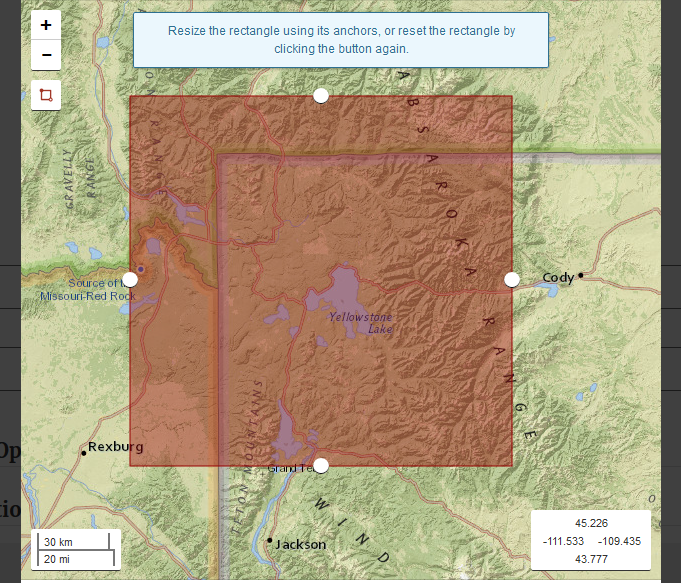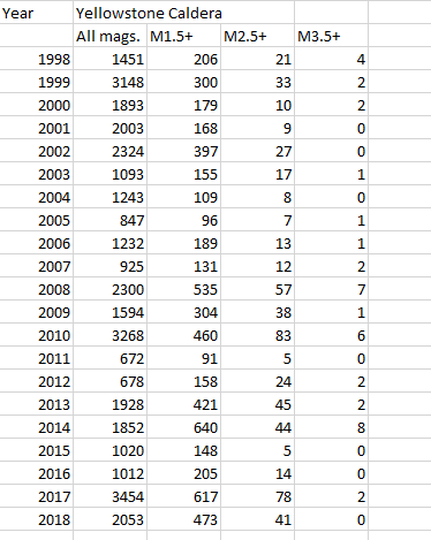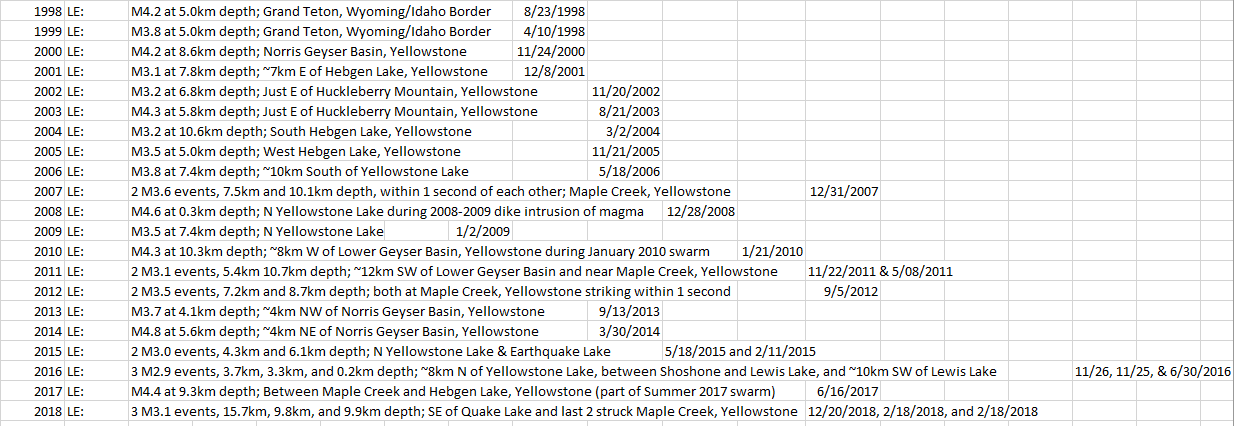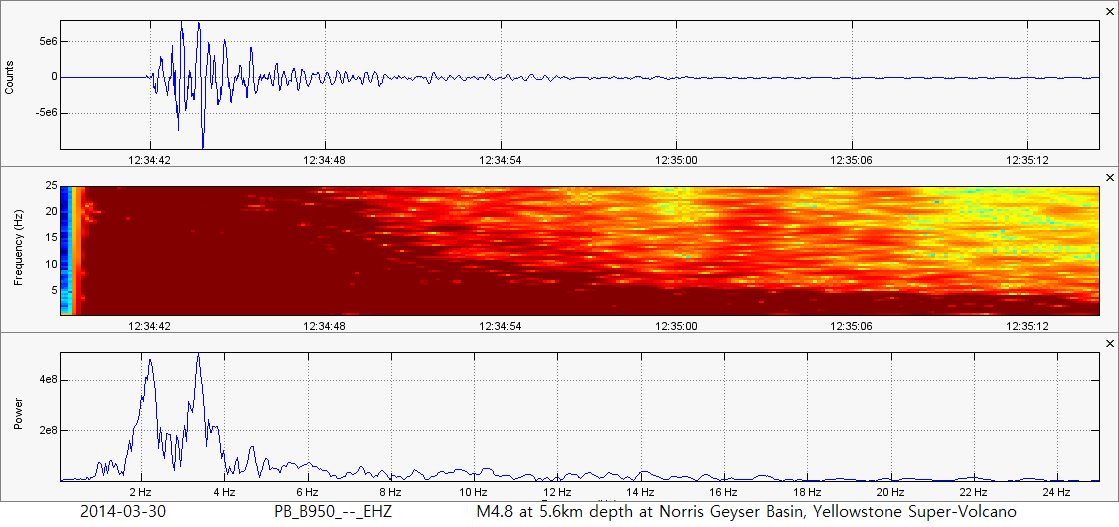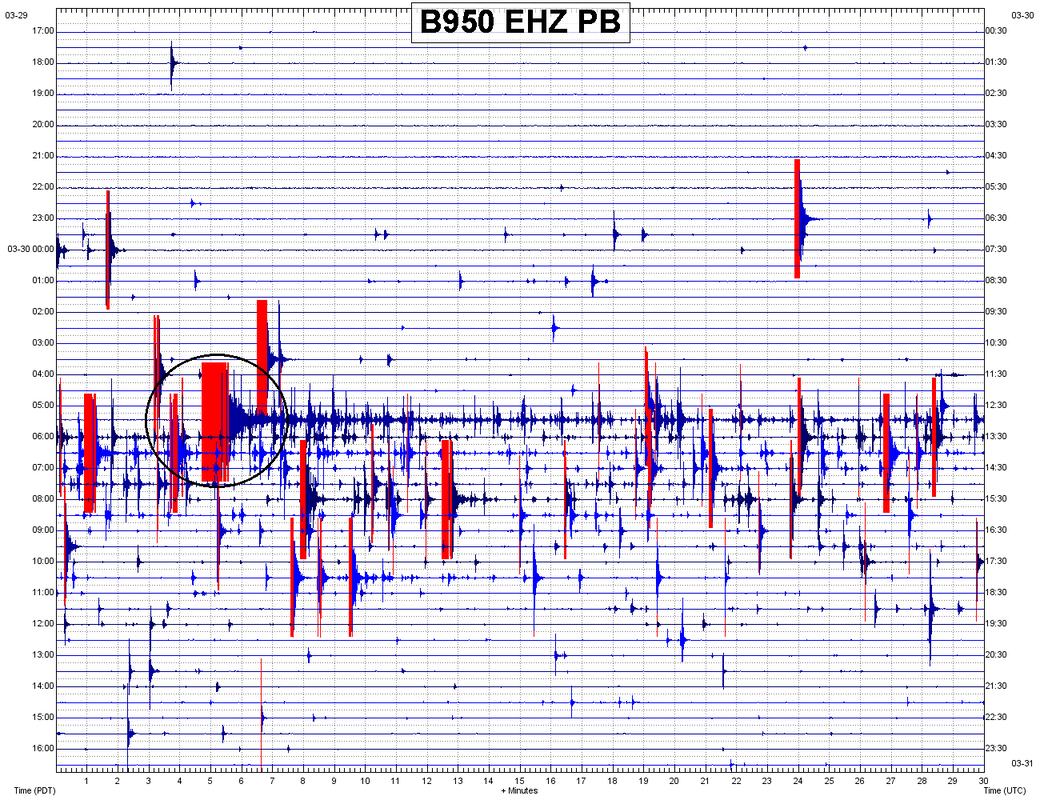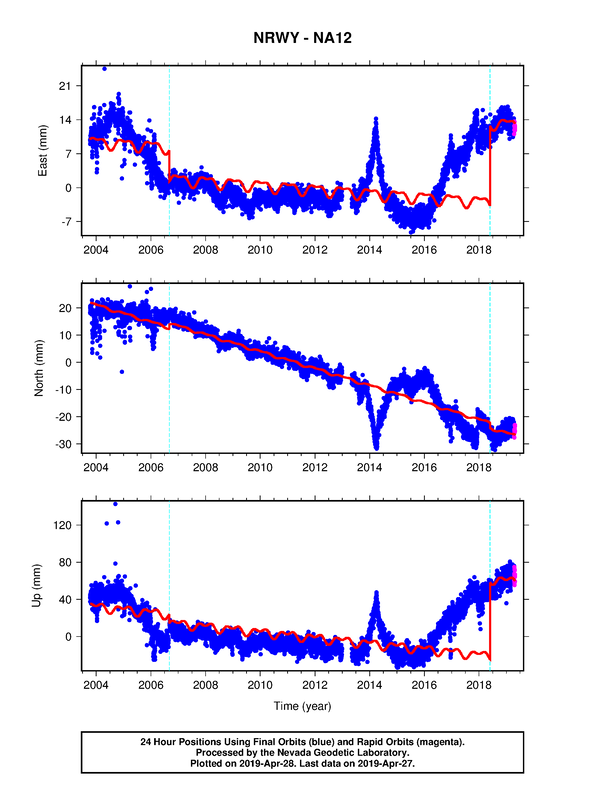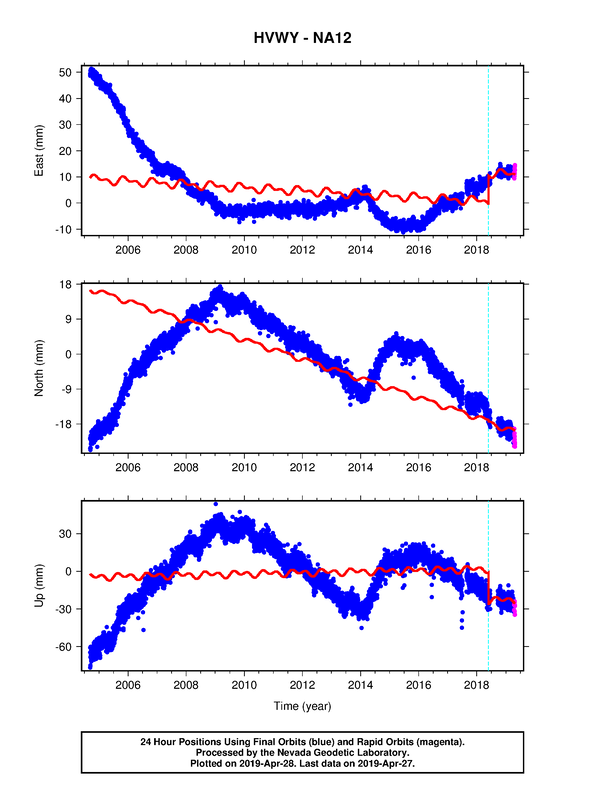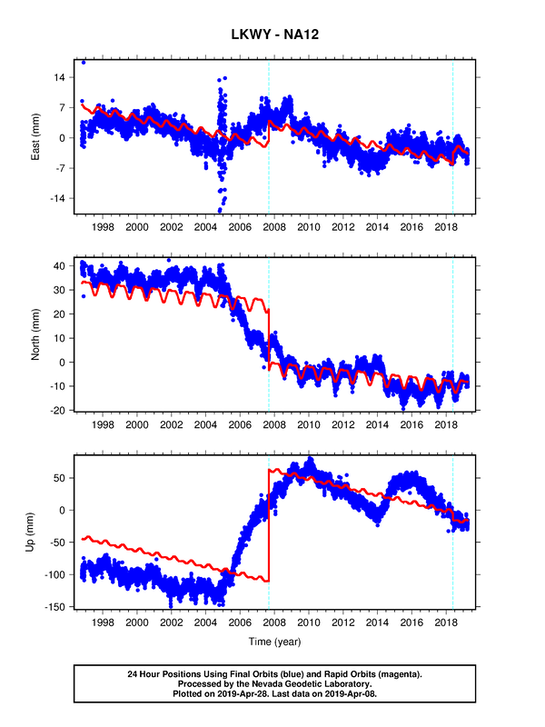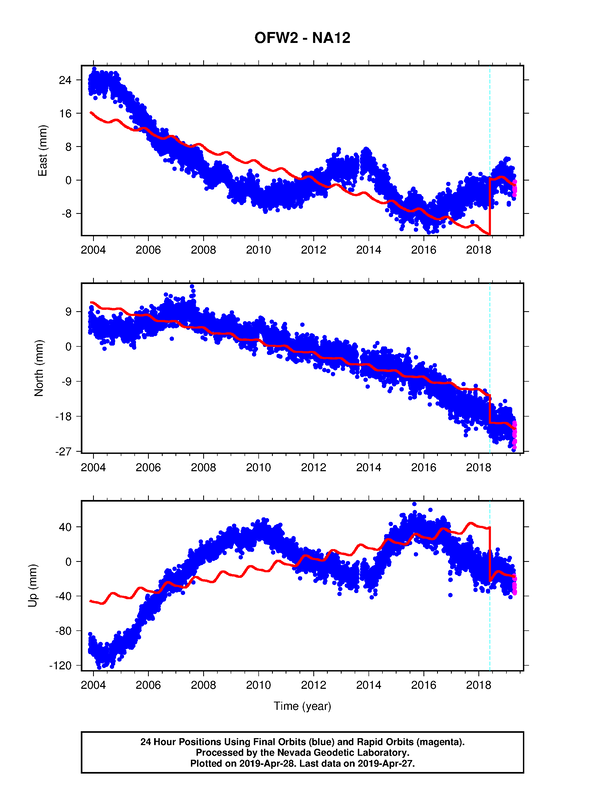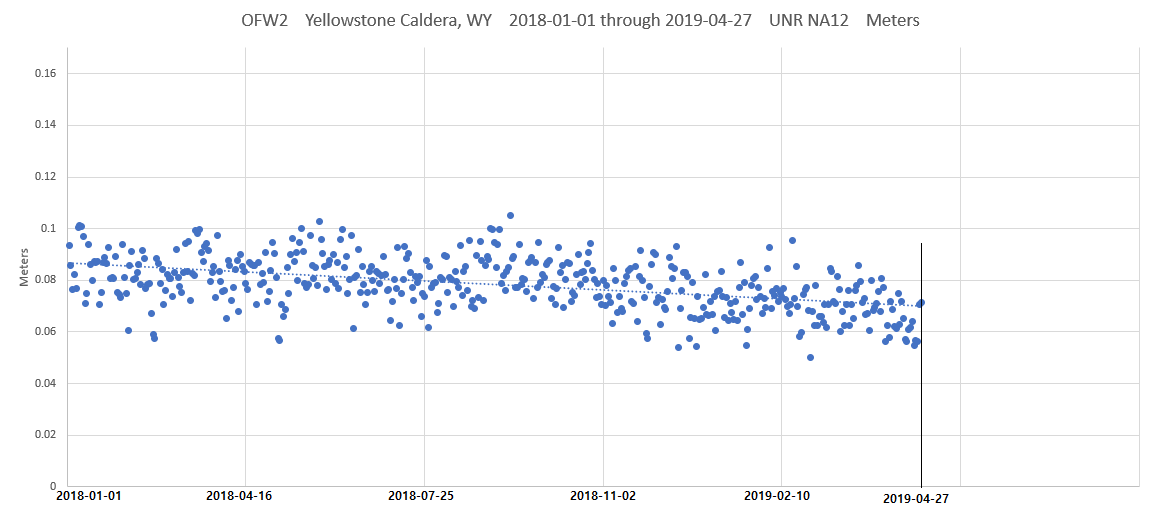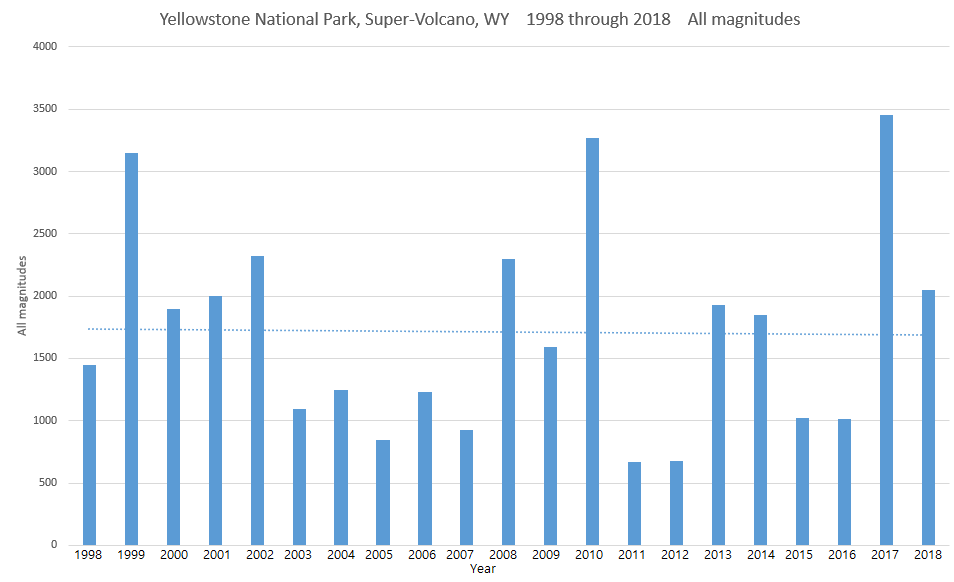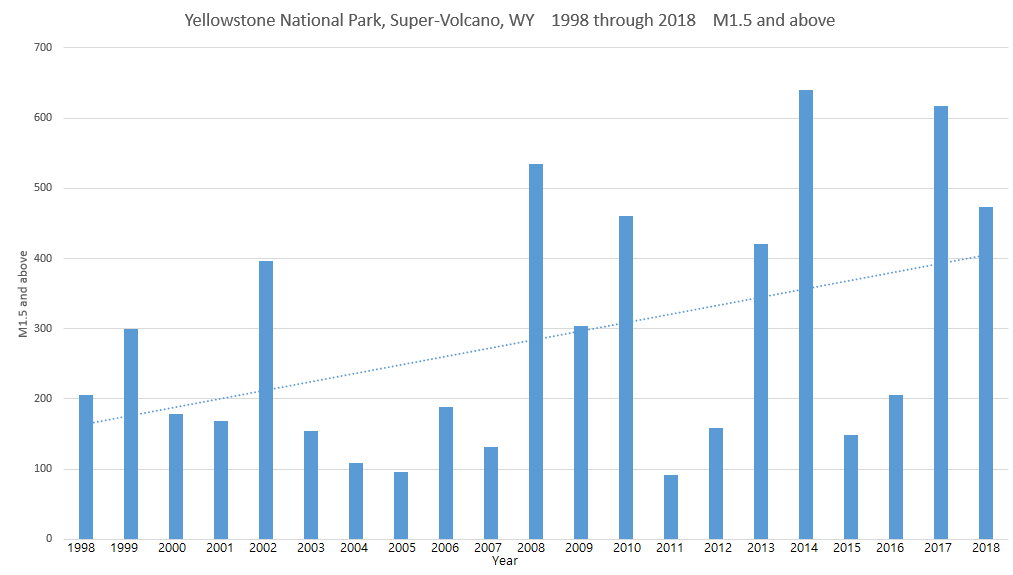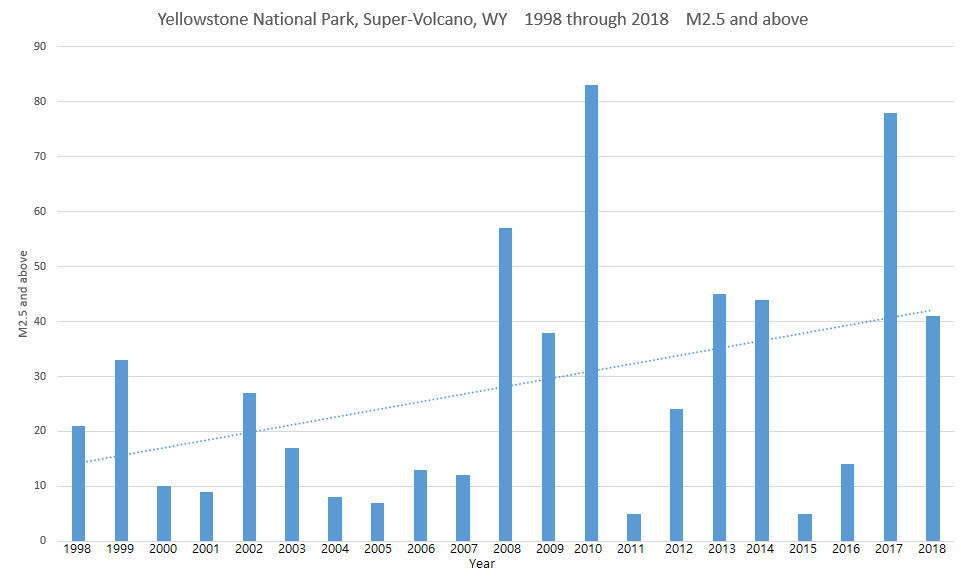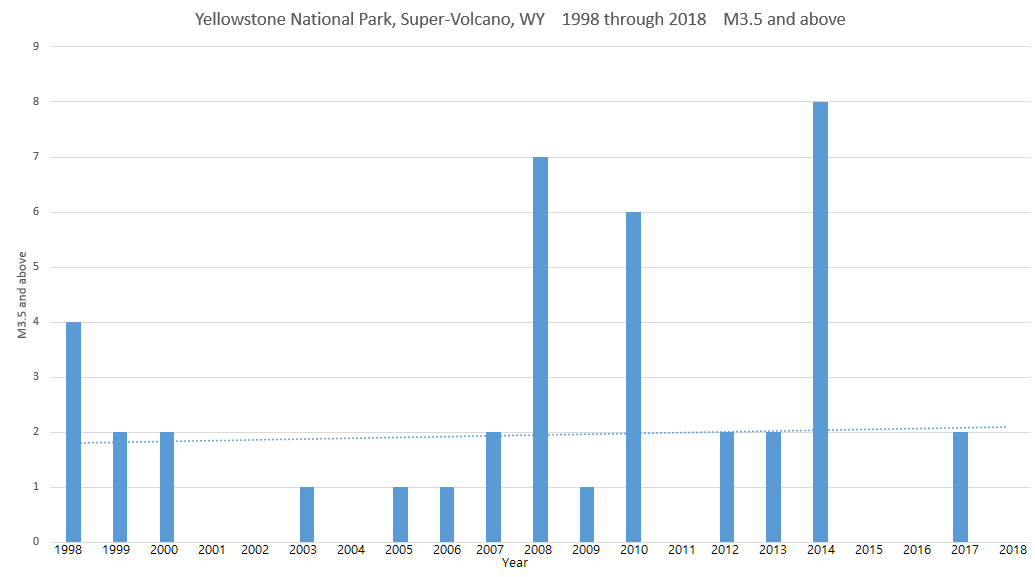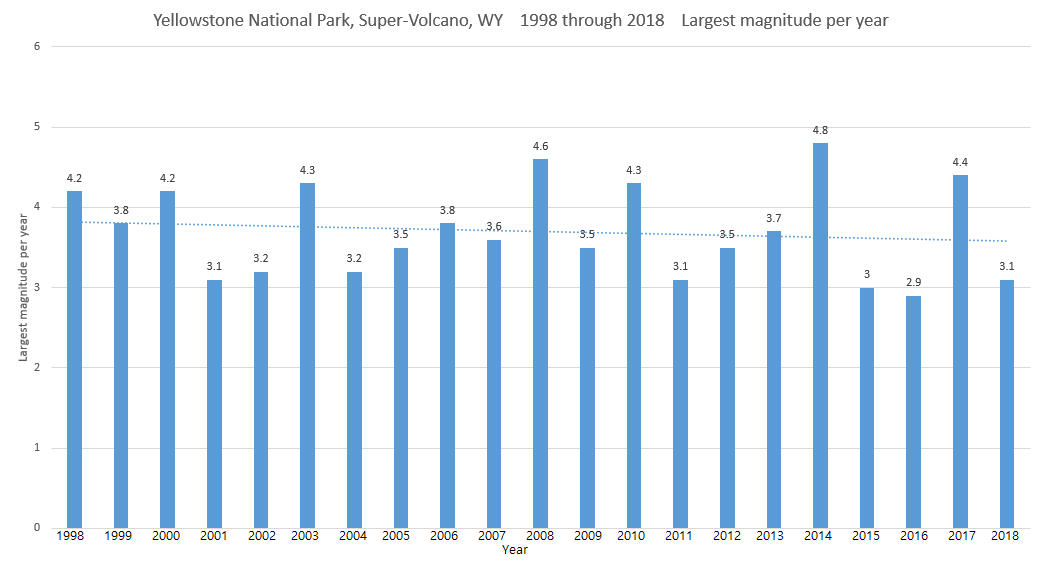The events contained within these statistics are the earthquakes REPORTED, not the ACTUAL number of earthquake events. As of the past few years, record keeping has gained momentum thanks to new technology and equipment updates. However, there are still earthquakes that are not reported by USGS even though the seismic trace of some events in question show on multiple seismic stations *shrug*. However this usually only occurs during earthquake swarms, especially at Yellowstone, and with magnitudes generally below M2.0. Every location in question will have at least 4 magnitudes showing all the earthquakes that occurred within that year at and above the magnitude in question. For example, all magnitudes, M1.5+, M2.5+, and M3.5+. But in regard to the Cascadia Subduction Zone, since it sees larger magnitudes than volcanoes, I will do all magnitudes, M2.5+, M4.0+, M5.0+, and M6.0+. I will also show the coordinate box I used and personal charts I created to give the reader a sense of how earthquake activity supposedly progressed for each magnitude throughout the years. I will also leave some GPS deformation charts if possible. As of right now, it seems earthquake counts for Long Valley caldera and the Cascadia Subduction Zone are more accurate than, for example, Newberry Caldera. Newberry didn’t have accurate seismic monitoring installed until 2011-2012. All earthquake statistics are taken directly from the earthquake catalog at earthquake.usgs.gov. Please let me know if there is anything I should change or if there are any mistakes! Of course these earthquake statistics will be updated once per year. I also encourage others to do the same that I have done!
One more thing. 0.0km in depth means sea level. So if you see an earthquake with a depth of -1.5km, but the elevation of the surface is only 1.0km for example, then that means the earthquake occurred in the air. We know that is not possible so if that is true for any of the events, then that means the depth is likely to be very wrong. Another thing to add is the increase of seismic monitoring since 1998. Places like Long Valley caldera and the Cascadia Subduction Zone should not see too noticeable of an increase in reported seismicity that is related to increased monitoring, basically since these areas have been monitored closely for longer than 1998. But places like Yellowstone and Newberry caldera, the low-magnitude seismicity might increase slightly throughout time because of increased monitoring, especially in regards to Newberry. But in regards to Yellowstone, a great many small events are still not reported to this day (it being 2019 right now). This can especially be proven on my West Thumb, Yellowstone page under the Seismic Events dropdown menu above. Many, many small events are not reported even though monitoring is sufficient enough for in depth reporting. I don’t know why this is occurring, so Yellowstone might have a slightly higher seismicity count than the reported count. But most of the time, quakes above M1.5 or so are reported regardless.
Earthquake counts are shown first, charts visualizing progression of seismicity are shown second, and my take on the seismic progression is at the bottom. Any additional information will be provided right below. Also, my charts will contain a horizontal trendline (rising, dropping, or level). I know these are important, yes. However trendlines should not be the most important thing to look at. I have seen trendlines head downwards many times when recent activity has started to spike, giving a false sense of recent activity. They are important, but remember to always look at the data first. All dates are in UTC. UTC is ahead of Pacific Time, for example, by 7 hours. This means, for example, an earthquake occurring at 1:00UTC on April 22 would still be April 21 for us here in the USA.
Also, in regards to the largest event section, "LE" means largest event. If dealing with multiples of the same magnitudes, I will post in order from most recent. If you wish to know the locations of any of the GPS stations listed below, either CLICK HERE for the UNR map (where I got some of the deformation plots below) or CLICK HERE for the UNAVCO map. I highly suggest using the UNR map, seeing that you can see all-time plots.
One more thing. 0.0km in depth means sea level. So if you see an earthquake with a depth of -1.5km, but the elevation of the surface is only 1.0km for example, then that means the earthquake occurred in the air. We know that is not possible so if that is true for any of the events, then that means the depth is likely to be very wrong. Another thing to add is the increase of seismic monitoring since 1998. Places like Long Valley caldera and the Cascadia Subduction Zone should not see too noticeable of an increase in reported seismicity that is related to increased monitoring, basically since these areas have been monitored closely for longer than 1998. But places like Yellowstone and Newberry caldera, the low-magnitude seismicity might increase slightly throughout time because of increased monitoring, especially in regards to Newberry. But in regards to Yellowstone, a great many small events are still not reported to this day (it being 2019 right now). This can especially be proven on my West Thumb, Yellowstone page under the Seismic Events dropdown menu above. Many, many small events are not reported even though monitoring is sufficient enough for in depth reporting. I don’t know why this is occurring, so Yellowstone might have a slightly higher seismicity count than the reported count. But most of the time, quakes above M1.5 or so are reported regardless.
Earthquake counts are shown first, charts visualizing progression of seismicity are shown second, and my take on the seismic progression is at the bottom. Any additional information will be provided right below. Also, my charts will contain a horizontal trendline (rising, dropping, or level). I know these are important, yes. However trendlines should not be the most important thing to look at. I have seen trendlines head downwards many times when recent activity has started to spike, giving a false sense of recent activity. They are important, but remember to always look at the data first. All dates are in UTC. UTC is ahead of Pacific Time, for example, by 7 hours. This means, for example, an earthquake occurring at 1:00UTC on April 22 would still be April 21 for us here in the USA.
Also, in regards to the largest event section, "LE" means largest event. If dealing with multiples of the same magnitudes, I will post in order from most recent. If you wish to know the locations of any of the GPS stations listed below, either CLICK HERE for the UNR map (where I got some of the deformation plots below) or CLICK HERE for the UNAVCO map. I highly suggest using the UNR map, seeing that you can see all-time plots.
Yellowstone seismicity counts:
Largest magnitudes per year:
Largest event from 1998 through 2018 was a M4.8 at 5.6km depth; ~4km NE of Norris Geyser Basin, Yellowstone on 3/30/2014. Plots shown directly below.
GPS horizontal and vertical deformation for Yellowstone Caldera (obtained via UNR; link above):
My custom GPS deformation plot showing vertical (uplift/subsidence) deformation for station OFW2, from January 1, 2018 through April 27, 2019, which resides at the Mallard Lake resurgent dome at Yellowstone Caldera (raw data obtained from UNR; plot created by me):
Charts detailing data from the spreadsheets above:
My opinions/educated guesses:
As we can see with the GPS deformation chart I provided, which shows uplift/subsidence patterns from January 1, 2018 through April 27, 2019 for station OFW2 near the Upper Geyser Basin, subsidence still continues at the caldera at a slow rate. This will all be updated by next year or whenever uplift starts again, whichever comes first. Now look at the plots generated by UNR (the blue ones above mine). Those show a much longer time frame (please remember to look at the dates). Note the two episodes of substantial uplift? The increased uplift sort of coincides with the reported seismicity. We have not been at such levels since around late-2006! I do suspect another round of uplift will start again, seeing this has happened many times in the past. That is just a theory, however, and could be wrong.
Now to the charts showing the progression of reported seismicity. Sometimes small quakes below M1.5 or so are reported more often in later years due to increased seismic monitoring. However we really do not see that here. Note the "All magnitudes" chart. It doesn't seem to be increasing or decreasing. Kind of like it is breathing. Some years get alot of quakes, others do not. As for the "M1.5 and above" and the "M2.5 and above" charts, we see reported events above M1.5 have been increasing. Again, I highly doubt most of the increase is due to increased monitoring. Yellowstone has had the capability of locating M1.5 and above earthquakes for quite some time. Remember, the smaller the earthquake, the harder to locate if not within a dense network. Earthquakes M1.5 and above, again, do seem to be increasing slightly. The same cannot be said for earthquakes reported to be M3.5 and above. You can also see this on the last chart at the bottom which shows the maximum magnitude for each year.
Overall, it does look like seismicity has slightly increased over the past 2 decades for magnitudes above M1.5, mostly in the past 10 years since 2008. Coincidentally, late-2008 is also the time Yellowstone Lake saw quite an impressive intrusion of magma under the northern tip. Over 800 quakes struck the area within less than a week and the largest earthquake was a sort of "explosive" earthquake just under the lake. If you wish to see some of that swarm, simply goto the Seismic Events dropdown menu above and click 2008-2009 Yellowstone Lake. Again, quake activity does seem to be slightly increasing over the past decade. It is hard to tell though. But smaller magnitudes seem to not really carry a substantial trend. Although Yellowstone contains a vast and dense seismic network, there are still a great many earthquakes smaller than M1.5 or so that are not reported even though their P and S waves are clearly seen on many stations. I am unsure why this is, seeing other locations with smaller networks can still report many small micro-quakes and micro-quake swarms. You can especially see this on my West Thumb, Yellowstone page in the Seismic Events dropdown menu above. So the reported amount of earthquakes are likely accurate for events larger than M1.5. But the "All Magnitudes" chart is likely going to give you a wrong sense of real activity.
Now to the charts showing the progression of reported seismicity. Sometimes small quakes below M1.5 or so are reported more often in later years due to increased seismic monitoring. However we really do not see that here. Note the "All magnitudes" chart. It doesn't seem to be increasing or decreasing. Kind of like it is breathing. Some years get alot of quakes, others do not. As for the "M1.5 and above" and the "M2.5 and above" charts, we see reported events above M1.5 have been increasing. Again, I highly doubt most of the increase is due to increased monitoring. Yellowstone has had the capability of locating M1.5 and above earthquakes for quite some time. Remember, the smaller the earthquake, the harder to locate if not within a dense network. Earthquakes M1.5 and above, again, do seem to be increasing slightly. The same cannot be said for earthquakes reported to be M3.5 and above. You can also see this on the last chart at the bottom which shows the maximum magnitude for each year.
Overall, it does look like seismicity has slightly increased over the past 2 decades for magnitudes above M1.5, mostly in the past 10 years since 2008. Coincidentally, late-2008 is also the time Yellowstone Lake saw quite an impressive intrusion of magma under the northern tip. Over 800 quakes struck the area within less than a week and the largest earthquake was a sort of "explosive" earthquake just under the lake. If you wish to see some of that swarm, simply goto the Seismic Events dropdown menu above and click 2008-2009 Yellowstone Lake. Again, quake activity does seem to be slightly increasing over the past decade. It is hard to tell though. But smaller magnitudes seem to not really carry a substantial trend. Although Yellowstone contains a vast and dense seismic network, there are still a great many earthquakes smaller than M1.5 or so that are not reported even though their P and S waves are clearly seen on many stations. I am unsure why this is, seeing other locations with smaller networks can still report many small micro-quakes and micro-quake swarms. You can especially see this on my West Thumb, Yellowstone page in the Seismic Events dropdown menu above. So the reported amount of earthquakes are likely accurate for events larger than M1.5. But the "All Magnitudes" chart is likely going to give you a wrong sense of real activity.
